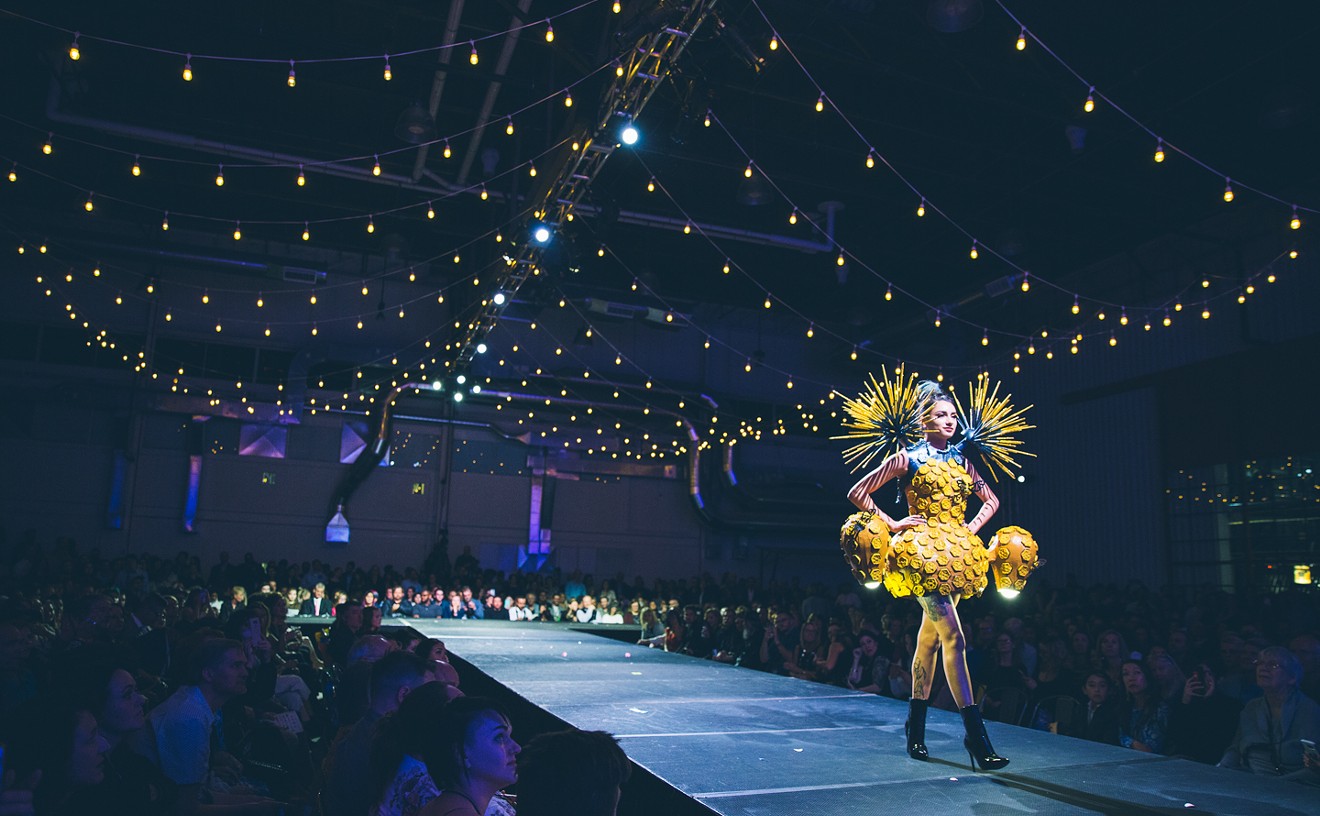This year's season opener at the Wazee Street gallery features recent landscape paintings by nationally known Boulder-based artist Chuck Forsman. It's a beautiful exhibit that inaugurates a fall and winter schedule ripe with promise. Other events planned at Robischon include an exhibition next month focusing on Christo's works in progress and, after the first of the year, an exhibit of Robert Motherwell prints.
The paintings in the self-titled show Chuck Forsman are described by the artist as being among the last of his famed "Arrested Rivers" series. These works, which depict dams in the American West, may be familiar to viewers--an abbreviated "Arrested Rivers" traveling show made it to Auraria's Emmanuel Gallery last year.
Forsman began the series in the late 1980s and went on to devote the next several years to it. But he says he didn't plan it that way. "I'm not calculating," he says. "It just started."
Born in Idaho and raised in Oregon and California, Forsman came to Boulder in 1971 when he was hired as a fine-art professor by the University of Colorado. Twenty-five years later, Forsman still teaches at CU. Before arriving in Colorado, he studied in the late 1960s at the University of California at Davis, known at the time as a place where radical ideas in painting were in the air--notably, a post-abstract return to representation. One of Forsman's mentors was Davis professor and West Coast pop artist Wayne Thiebaud, who championed contemporary representational art.
The young Forsman started out as a traditional realist. "I had always lived in small towns, I had been in the service in Vietnam, I was a conservative kid--and then my ideas were being challenged," he says. Forsman describes his mature work as being a hybrid of his own conservatism and the influence of the avant-garde he encountered during his early days at Davis.
Forsman spent years painting still lifes and other kinds of interior scenes. "I had always been an outdoor person," he says, "but as a Vietnam veteran, I was upset with the country, and so I went inside." It was in Boulder in the late 1970s that Forsman finally turned to landscapes. Enough time had passed since the end of the war, he says, that he felt released from his "guilt and anxiety" and began to look at the world with fondness again.
But for someone who loves the great outdoors, Forsman spends a lot of time depicting sites that spoil the view: His landscape paintings have always focused on modern civilization's encroachment on the wilderness. The paintings from the "Arrested Rivers" series at Robischon put dams--and the berms and road cuts that accompany them--right in the center of the frame. The artist's palpable disapproval of society's rape of the scenery, which is often glimpsed in the background, is everywhere. But interestingly, Forsman also seems to have an appreciation for man-made wonders--he makes the dams look good, too. As he explains it, "a critique is meaningless without affection, and why would anyone make a meaningless critique?"
Forsman says he didn't set out to make the kind of bold statements that have since become a signature of his. For instance, he says he included power lines and billboards in his paintings not as social commentary but because he didn't know he was supposed to leave them out. "I was naive and unaware of the landscape tradition," he says. Nonetheless, his scenic panoramas of the 1970s, which documented society's detrimental presence, placed him at the forefront of the environmental-art movement.
The paintings at Robischon, all of which were painted in the last year or so, clearly suggest the need to protect the natural world. Forsman, however, says that's just part of what's going on in his work. "The content is important, but I'm also interested in making beautiful paintings," he says. It's an attitude that has brought him into conflict with some environmentalists, who feel his work should reveal the ugliness, not the beauty, of the dams. Fortunately, Forsman seems immune to such pressure.
In both the handling of the scenery and the small figures used to suggest the great scale of the dams, Forsman's paintings broadly recall the work of the American scene painters of the early twentieth century. It follows that he would include Edward Hopper among the scores of historical figures he believes inspired him. Other influences are less expected, like Italian master Giotto and post-impressionist pioneer Paul Cezanne.
The Forsman show at Robischon includes seven paintings, all but one of which are fairly large. Most have irregular margins, but the idiosyncratic shapes are not meant by Forsman to carry any narrative weight. Instead, according to the artist, they represent case-by-case accommodations to specific compositional problems. Forsman says he turned to the irregular frames because he was taking in wider and wider views that he felt "wouldn't work in a rectangle."
The way Forsman's subjects determine the shape of his paintings is easy to see in "Ants," an oil on panel based on the Grand Cooley Dam. An arch over the left side allows Forsman to include some extra clouds over a mountain. In "Night of Sad Miracles," instead of extending the sky, the arch crops it; additionally, Forsman has cut off the bottom left corner of the foreground.
The use of irregular margins is only the most obvious way in which these paintings break with the landscape tradition. Another is the arrangement of recognizable forms into a geometric abstract. In the superb "Feather River," the dam, the river and the mountains in the distance create a dense tangle of diagonal lines. The colors, too, reinforce the simple shapes used to make up the scene. For example, Forsman employs a variety of grays to convey the dam and the rocks in the foreground, which then collide with the golden browns of the water and grasses. The effect is to further simplify a composition already reduced through the use of unifying diagonals.
In one of Forsman's most recent paintings, "Imagine This," a hillside has been so radically altered through construction that it might as well be an abstract itself. The diagonal lines are pronounced, both in the roads that fill the middle of the frame and in the jet contrails that line the sky. The blue sky, ocher land and dark-brown shadows are essentially horizontal forms stacked one on top of another.
Forsman's creation of art heavy with narrative content but light on polemics is echoed in another individual show now at Robischon. Though quite different from Forsman's show, the work in William Jackson Maxwell is also concerned with preserving the environment.
The relatively small and delicate Maxwell works here mark a radical departure for the artist, who is best known for large public commissions, most notably the propeller-lined train tunnel at Denver International Airport that he completed with Antonette Rosato. But just like that whimsical effort, the mixed-media wall pieces from Maxwell's "Fallen Leaves" series, along with his installation "Firewater," use light and movement--or their suggestion--as key elements.
The "Fallen Leaves" pieces are free-form arrangements of dried leaves suspended between sheets of transparent glass. Each of the pieces is dedicated to a different extinct bird. Maxwell has written that he chose to focus on the birds because they are the first animals to succumb to pollution.
The contemplative "Firewater" is made up of three principal elements: a transparent acrylic table held up by clear acrylic tubes and, on either side of it, a pair of transparent vertical panels. Dried leaves have been placed at the top of each tube immediately under the table top, which is filled with water that drips from a box mounted on the ceiling. The table never overflows, however, because the water continuously evaporates. The large vertical panels contain elaborate and traditionally decorative arrangements of dried plants and flowers in red wooden frames. The sound of the dripping water and the illusion of the leaves seeming to float below it provide the perfect ironic contrast to the transparent synthetic materials.
Both Forsman and Maxwell are committed ecologists. But they're equally committed to doing things their own way. It's a contrast that makes this current pairing at Robischon an inspired call.
Chuck Forsman and William Jackson Maxwell, through November 2 at the Robischon Gallery, 1740 Wazee Street, 298-7788.










